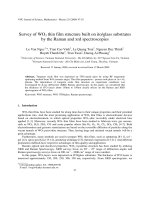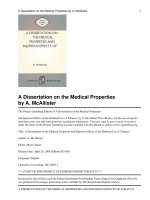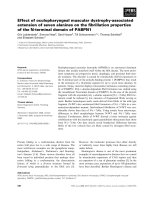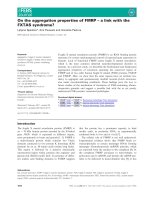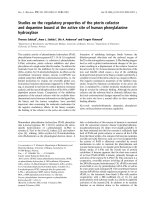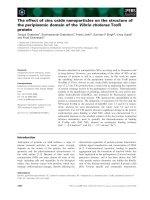Influences of titanium oxide additions on the electrochromic properties of WO3 thin films
Bạn đang xem bản rút gọn của tài liệu. Xem và tải ngay bản đầy đủ của tài liệu tại đây (2.77 MB, 175 trang )
Influences Of Titanium Oxide Additions On The
Electrochromic Properties Of WO
3
Thin Films
Gui Yang
A THESIS SUBMITTED
FOR THE DEGREE OF Ph.D. OF ENGINEERING
DEPARTMENT OF MATERIALS SCIENCE AND
ENGINEERING
NATIONAL UNIVERSITY OF SINGAPORE
2015
ii
iii
Acknowledgment
First and foremost, I am sincerely thankful to my supervisor, A/P Daniel John
Blackwood, whose encouragement, patient and support from the initial to the
final level enabled me to develop an understanding of the project. I am grateful
to his invaluable advice, support, detailed instructions and guidance throughout
of years of my study. It is extremely pleasant to work with him.
I would like to express my cordial thanks to Dr. Wang Qing and A/P Stefan
Adams for their heartily suggestions during my qualification examination.
The support from the students and staffs in their research group is mostly
appreciated.
I will take this opportunity to appreciate the friendship and support from my
group colleagues Dr. Pang Jianjun, Dr. Mohammad Reza Khajavi, Dr.
Seyyedhamed Mirabolghasemi, Dr. Liu Dongqing and Tan Yong Teck. I would
also like to extend my thanks to my dear friends Cho Swee Jen, Neo Chin Yong,
Mei Xiaoguang, Chen Mao Hua, Gu Wen Yi, Yang Zheng Chun, Zheng Min
Rui, Tang Chun Hua and Li Kang Le. In addition, I have to give my deepest
thanks to all the staffs in MSE department.
Last, but not least, I am especially grateful to my family members for their
unconditional love, encouragement and support.
iv
Table of Contents
DECLARATION 错误!未定义书签。
Acknowledgment iii
Table of Contents iv
Summary vi
List of Tables x
List of Figures xii
List of Symbols xvii
Chapter 1 Introduction 1
1.2 Brief review of the development of research on electrochromic transition
metal oxides 5
1.3 Fundamental researches on tungsten oxides 7
1.3.1 Structural models for amorphous tungsten trioxide 8
1.3.2 Crystal structures for tungsten trioxide 9
1.3.3 Electrochromic mechanisms for tungsten trioxide crystalls 10
1.4 Methods of synthesis of tungsten oxide 11
1.4.1 Sol-Gel 11
1.4.2 Hydrothermal method 12
1.4.3 Electrodeposition 13
1.4.4 Electrochemical anodization 15
1.4.4.1 Researches on anodic oxidation of tungsten 16
1.4.4.2 Electrochemical anodization mechanism 18
1.4.4.3 Effects of anodization parameters on WO
3
structure 19
1.5 Investigations on electrochromism of metal/metal oxide doped WO
3
films . 23
1.6 Scope of this thesis 26
References: 27
Chapter 2 Experiments Details 36
2.1 Preparation of Samples Used for Hydrothermal Method 36
2.1.1 Substrates cleaning 36
2.1.2 Seed layer fabrication 36
2.1.3 Hydrothermal deposition 37
2.2 Preparation of Samples Used for Anodic Anodization 38
2.2.1 Film deposition by magnetron sputtering 38
2.2.2 Anodization of W/Ti thin films in organic solution 39
2.2.3 Anodization of W/Ti thin films in aqueous solution 40
2.3 Characterization 40
2.3.1 Morphology, Elemental Distribution and Structure Characterization . 40
2.3.2 Electrochemistry Characterization 41
2.3.3 Characterization of Electrochromic Feature 43
References 43
Chapter 3 A self-assembled two-layer structured TiO
2
doped WO
3
film
with improved electrochromic capacities 44
3.1 Introduction 44
3.2 Result and discussion 45
3.2.1 Morphology and composition analysis 45
3.2.2 Structural analysis 51
3.2.3 Electrochemical analysis 54
v
3.2.4 Electrochromic results 57
3.2.5 Electrochemcial impedance analysis 65
3.3 Conclusions 70
References: 72
Chapter 4 Comparison of WO
3
and TiO
2
doped WO
3
thin films formed
by co-anodizing in organic solutions and their electrochromic
properties 75
4.1 Introduction 75
4.2 Results and discussion 77
4.2.1 The anodization transient curves 77
4.2.2 Morphology observation and corresponding elemental distribution
analysis 79
4.2.3 Structural analysis 86
4.3.4 Raman spectroscopy 91
4.2.5 XPS investigation 94
4.2.6
Cyclic Voltammetry 95
4.2.7 Electrochromic properties 99
4.2.8 UV-vis spectroscopy 106
4.2.9 Electrochemical Impedance Spectroscopy 107
4.3 Conclusions 109
References: 110
Chapter 5 Studying on influence of different amount of TiO
2
dopants on
the electrochromic property of WO
3
113
5.1 Introduction 113
5.2 Results and discussions 115
5.2.1 Morphology and elemental distribution analysis 115
5.2.2 Structural analysis 122
5.2.3 Cyclic voltammetry 130
5.2.4 Electrochromic properties 136
5.2.5 Electrochemical Impedance Spectrum 143
5.3 Conclusions 146
References: 147
Chapter 6 Conclusions 150
References 155
Chapter 7 Suggestions on future research work 156
vi
Summary
This thesis aims to investigate TiO
2
doped WO
3
thin films and their
corresponding electrochromism properties as a candidate for application on
“Smart Windows”. The configuration of the entire thesis includes seven
chapters. In chapter 1, a brief introduction on the importance of electrochromic
concept and literature review focusing on tungsten oxide based electrochromic
materials have been presented. Through reviewing the works done by other
scientists, the properties of tungsten oxide and the corresponding development
on “Smart Windows” application based on WO
3
system have been exhibited.
Through comparing the fabrication methods, the hydrothermal and co-
anodization technique provides the advantages and conveniences on producing
oxides thin films on the desired substrates with different morphologies.
Moreover, to the best of my knowledge, co-anodizing of Ti/W thin film for
electrochromic investigation has not been reported except in this thesis. Next,
the experimental methods are elaborated in chapter 2, with results and
discussion presented in the later chapters. In chapter 2, the specific methods
used for the thin film synthesis have been listed. Furthermore, the related
characterization and testing conditions have been stated in this chapter as well.
In chapter 3, the critical technique used for the synthesis of TiO
2
doped WO
3
thin film is one step hydrothermal method which has the benefit of producing
thin films with good crystallinity. In addition, the hydrothermal parameters,
containing hydrothermal time, temperature and precursor proportion in
vii
hydrothermal proportions, are easily controlled. The hydrothermally
synthesized TiO
2
doped WO
3
thin films show two layer structures consisting of
nanopillars on top of a compact layer with uniform Ti/W atomic ratio of 4:1. In
the present work, on the one hand, this thin film presents a large light
transmittance change range of 67% at 632.8 nm, twice that of an equivalent pure
WO
3
film. On the other hand, its coloration efficiency is increased by 50% to
39.2 cm
2
C
-1
. Additionally, it is well adhered to the substrate and shows good
electrochromic reversibility. In the colored state, the transmittance of the TiO
2
doped WO
3
thin film within visible light range is below 5%, whilst in the bleach
state this exceeds 70%.
Continuing the observation from chapter 3 which demonstrates the improved
electrochromic property through doping TiO
2
into WO
3
host, chapter 4 also
investigates the TiO
2
doped WO
3
thin film but this time the film is produced by
the co-anodization of co-sputtered Ti/W thin film in an organic solution. The
purpose is to obtain the thin films with different nano-morphologies with
improved specific surface area and convenient charge transport channels like
pores to further enhance its electrochemical kinetic properties. The synthesized
TiO
2
doped WO
3
thin film, with titanium atomic percentage of ca. 10 at.%,
shows honeycomb structure with macro-porous surface. The light transmittance
change range of this anodized film can reach at 70% at the wavelength of
632.8nm which is 12% higher than an equivalent pure WO
3
thin film. It also
viii
exhibits higher reversibility of 93% and coloration efficiency at a wavelength
of 800nm of 64cm
2
/C, compared to 73% and 19cm
2
/C for the pure WO
3
thin
film.
Based on these improvements on electrochromic properties by doping TiO
2
into
WO
3
thin films in chapter 4, chapter 5 studies the effect of different amounts of
titanium atoms in the WO
3
matrix on the related morphological, structural,
electrochemical and electrochromic properties of the thin films. Furthermore, in
this chapter, the pure thin film and the titanium doped thin films are anodized
in aqueous acidic solutions, as this is more attractive to industry than an organic
solvent. It was observed that the morphology of the thin films undergoes an
evolution from nano-pores, nano-flake to nano-block interweaved porous
structures accompanying with Ti atomic percentage varies from 0%, 7%, 10%
and 15%. The electrochromic experiments demonstrate that the optimum
titanium level is 10 at.%, with the TiO
2
doped WO
3
film at this level having a
transmittance change range of 58.5%, 72% and 77.7% at 550 nm, 632.8 nm and
800 nm respectively, which is more than a 25% improvement at all wavelengths
over a pure WO
3
film formed in the same way. The 10 at.% titanium film also
provided shorter coloration/bleach times, especially in the critical near infrared
region with values of 10 s/64 s compared with 32 s/90 s of a pure WO
3
thin film.
Finally, cyclic voltammetry showed that the addition of titanium improved the
film’s stability, with the best films losing less than 5% of their capacity after
ix
1000 switching cycles.
Finally, physical characterization of the various electrochromic thin films was
also conducted. In all cases, XPS spectroscopy proves that the valence of
tungsten and titanium elements in both as prepared pure WO
3
and TiO
2
doped
WO
3
thin films were 6+ and 4+ respectively without any traces of alternative
valences. In addition, both XRD and Raman results revealed no evidence of
separate TiO
2
phases, with indications that the Ti
4+
replaced W
6+
within the
WO
3
lattice causing a reduction in the structural crystallinity.
x
List of Tables
Table 3.1 Element distribution list corresponding to the SEM-EDS results
Table 3.2 Lattice parameters of pure WO
3
and Titanium doped WO
3
thin films
after refinement
Table 3.3 Influence of wavelength on the coloration efficiency, the coloration
and bleaching times and the transmittance modulation range for the two types
of film.
Table 3.4 Parameters determined from fitting the EIS data to the equivalent
circuit in Figure 3.14, along with the variation between nominally the same
films and the percentage fit errors that give an indication of the quality of the fit
to an individual film (see Chapter 2).
Table 4.1 List of peak positions for pure WO
3
and TiO
2
doped WO
3
films
Table 4.2 Charge density list of pure WO
3
and TiO
2
doped WO
3
thin films for
their first cycle in CV test
Table 4.3 List of optical and kinetic parameters for pure WO
3
and TiO
2
doped
WO
3
thin films obtained from Figure 4.13 and 4.14 at wavelengths of 550,
632.8 and 800 nm.
Table 4.4 List of electrochromic rate parameters for pure WO
3
and TiO
2
doped
WO
3
at wavelengths of 550, 632.8 and 800 nm respectively
Table 4.5 List of impedance fitting parameters for the pure WO
3
and TiO
2
doped
WO
3
thin films
Table 5.1 List of XRD peak positions for WT0, WT7, WT10 and WT15
Table 5.2 Binding energy list of atoms orbits of W4f, Ti2p and O1s for film
WT0, WT10, WT10 and WT15
Table 5.3 List of charge densities and charge/discharge rate of all films
corresponding to curves in Figure 5.8
Table 5.4 List of optical and kinetic parameters for WT0, WT7, WT10 and WT15
obtained from Figure 5.12 at wavelengths of 550, 632.8 and 800 nm
xi
Table 5.5 List of impedance fitting parameters of film WT0, WT7, WT10 and WT15
xii
List of Figures
Figure 1.1 Schematic of an electrolytic cell used in the electrodeposition process.
Figure 3.1 SEM images of a plan view of (a) TiO
2
doped WO
3
film, (b) pure
WO
3
film, a cross-sectional view of (c) TiO
2
doped WO
3
film and (d) pure WO
3
film.
Figure 3.2 SEM-EDS spectrum of TiO
2
doped WO
3
film. (a) Mapping result of
a top view and (b) Point distribution of a cross-sectional view of underlayer and
nano-pillar respectively. The insect image is the corresponding SEM image.
Figure 3.3. Schematic growth development of the two-layer structured TiO
2
doped WO
3
thin film
Figure 3.4 XRD patterns of pure WO
3
films and TiO
2
doped WO
3
films on FTO
substrates. Peaks of Hexagonal WO
3
recorded by ICDD No. 01-085-245g.
Figure 3.5 (a) HRTEM image of TiO
2
doped WO
3
nano-pillar and (b)
corresponding elemental distribution maps.
Figure 3.6 Cyclic voltammograms showing the 1
st
, 100
th
, 500
th
and 1000
th
cycles
for (a) TiO
2
doped and (b) pure WO
3
films in 1 M LiClO
4
dissolved in propylene
carbonate at a sweep rate of 50 mV s
-1
.
Figure 3.7 Comparison of (a) intercalated charge density against the number of
circles and (b) extracted charge density against the number of circles
corresponding to Figure 3.6. Solid squares with TiO
2
dopants, open triangles
without TiO
2
dopants. (The values and the corresponding deviation in the image
come from the average of the result based on conducting the test twice.)
Figure 3.8 UV-vis transmittance spectrum of the TiO
2
doped (red solid lines)
and pure (black dashed lines) WO
3
films in the colored and bleached states.
Figure 3.9 Digital photographs of the TiO
2
doped WO
3
films at different stages:
(a) as-prepared; (b) colored at -1.0 V for 30 s; (c) colored at -2.0 V for 30 s; (d)
bleached at 2.0 V for 60 s.
Figure 3.10 Chronoamperometry curves and the corresponding in situ
transmittance at 632.8 nm for TiO
2
doped WO
3
films (a), (b) and pure WO
3
films (c), (d). Recorded by switching the applied potential repeatedly between -
2.0 V and +2.0V vs Ag/Ag
+
in 1 M LiClO
4
dissolved in propylene carbonate for
60s and 100s respectively. Solid lines show the initial response, dashed lines
show the response after 500 cycles.
xiii
Figure 3.11 The variation of the in-situ change in optical density (ΔOD) versus
the charge density for the (a) TiO
2
doped WO
3
films and (b) pure WO
3
films.
The ΔOD was measured at 632.8 nm at a potential of -2.0 V Ag/Ag
+
. (Note that
the deviation of the CE is calculated based on the Figure 3.10(b). In Figure
3.10(b), the transmittance - time curve of TiO
2
doped WO
3
has four cycles, so
each cycle gives a value of CE, based on these values an average deviation of
the CE of TiO
2
doped WO
3
is obtained and shown in the above image. The value
of 23.8 is the average value of the four values of CE. The CE deviation of pure
WO
3
is obtained with the same method.)
Figure 3.12 in situ transmittance at 500nm (solid line), 632.8 nm (dashed line)
and 1200nm (dot-dash line) for pure WO
3
films (a) and TiO
2
doped WO
3
films
(b).
Figure 3.13 Nyquist plots for WO
3
films with (a) and without (b) TO
2
dopants
at -0.4V vs Ag/Ag
+
1 M LiClO
4
dissolved in propylene carbonate. (c)
Magnification of the high frequency region for the pure WO
3
film.
Figure 3.14 Equivalent circuit used to fit the impedance data of WO
3
films
both with and without TiO
2
dopants.
Figure 4.1 Characteristic anodization profiles of pure W and Ti/W thin film in
0.3 M NH
4
F solution dissolved in ethylene glycol/DI water solution (volume
ratio of 50:2). The anodize potential was increased from 0 V to 10 V at 50 mVs
-
1
and fixed at 10 V for 40 minutes.
Figure 4.2 elemental distributions of pure WO
3
film and TiO
2
doped WO
3
film
detected by SEM-EDS. Accordingly the titanium contributes 10 at.% of the
metallic component.
Figure 4.3 SEM images of (a) top and (b) cross section view for sputtered pure
W on conductive FTO glass and likewise (c), (d) for the co-sputtered Ti/W.
Figure 4.4 SEM images of films formed by anodization (a) Pure WO
3
thin film
top view; (b) TiO
2
doped WO
3
(10 at.% Ti) thin film top view; (c) Pure WO
3
thin film top view cross section; (d) TiO
2
doped WO
3
thin film cross section; (e)
TiO
2
doped WO
3
thin film bottom view. All these anodized film images were
captured after annealing at 450°С for 3 hours
Figure 4.5 Comparison of the XRD results before and after anodization of W
thin films with and without titanium. (Cubic structure
*
is indexed from ICDD
00-001-1204).
Figure 4.6 Comparison of the XRD results of pure WO
3
and TiO
2
doped WO
3
xiv
thin film formed by anodization after annealing at 450°С for 3h. The peaks
passed through by dash lines belong to FTO substrate.
Figure 4.7 High-resolution TEM image of (a) Pure WO
3
thin film formed by
anodization after scratching from FTO substrate and being dispersed in ethanol
on to a Cu grid. The inset is the region outlined by a square after performing a
reversed Fourier transform; (b) diffraction image corresponds to (a); (c) TiO
2
doped WO
3
thin film after the same process as pure WO
3
and (d) diffraction
image corresponding to (c)
Figure 4.8 Raman spectra of Pure WO
3
thin film and TiO
2
doped WO
3
thin film.
Figure 4.9 XPS spectra of the orbits of (a) W 4f, (b) O 1s and (c) Ti 2p
Figure 4.10 Cyclic voltammetry curves of (a) Pure WO
3
thin film and (b) TiO
2
doped WO
3
thin film. The CV is conducted in 1M LiClO
4
dissolved in
propylene carbonate solutions with a sweep rate of 50mV s
-1
from -2V to 1V
vs. Ag/Ag
+
. The solid line “一” denotes the first cycle; dash line “
“ denotes the 500
th
cycle and dotted line”……”denotes the 1000
th
cycle.
Figure 4.11 Comparison of inserted ion charge density at selected cycle numbers
corresponding to the cyclic voltammetry curves of pure WO
3
and TiO
2
doped
WO
3
thin film.
Figure 4.12 Chronoaperometry curves of pure WO
3
and TiO
2
doped WO
3
thin
films. The test is conducted by providing alternative potentials between -1 V
and 1 V vs. Ag/Ag
+
(0.1M AgNO
3
/0.01M TBPA in acetonitrile) for 50 s and
150 s respectively in 1 M LiClO
4
dissolved in propylene carbonate solutions.
Figure 4.13 (a), (b) and (c) are in-situ UV-vis kinetic curves corresponding to
Figure 4.12. The black and red solid line “一” represent △T%~ features of
the TiO
2
doped WO
3
thin film at the first and the last five cycles of 500
cycles
respectively; the dash line “ “ represents pure WO
3
thin film at its first five
cycles
Figure 4.14 (a), (b) and (c) are the related coloration efficiency at different
wavelengths. The filled square “■” represents the coloration efficiency of pure
WO
3
; empty square “□” for TiO
2
doped WO
3
at the 1
st
cycle and the filled
triangular “▲” for TiO
2
doped WO
3
at the 500
th
cycle
Figure 4.15 UV-vis spectra of pure WO
3
and TiO
2
doped WO
3
thin films in their
bleached and colored states and their corresponding optical images. “O” stands
for original state (i.e. before coloration); “C” for color state (after coloring under
-1 V for 50 s) and “B” for bleach state (after bleach under 1 V for 150 s”). The
xv
solid line “–––” denotes TiO
2
doped WO
3
thin film and the dash line “– – –”
represents pure WO
3
thin film.”
Figure 4.16 Electrochemical impedance spectra of the pure WO
3
and TiO
2
doped WO
3
thin films. The solid line is the fitting results, for the equivalent
circuit shown in Figure 3.14.
Figure 5.1 SEM images (a) top view and (b) cross section of as-sputtered pure
tungsten thin film. The morphologies of the as-sputtered tungsten/titanium thin
films with different atomic percentage of titanium do not show significant
variations from the pure WO
3
.
Figure 5.2 SEM top images of (a) WT0, (b) WT7, (c) WT10 and (d) WT15 films.
All these films were anodized in 0.3 wt% NaF dissolved in 1 M H
2
SO
4
under
40 V for 40 mins and annealed at 450°С for 3 h.
Figure 5.3 SEM cross section images of (a) WT0, (b) WT7, (c) WT10 and (d)
WT15 films. All these films were anodized in 0.3 wt% NaF dissolved in 1 M
H
2
SO
4
under 40 V for 40 mins and annealed at 450°С for 3 h.
Figure 5.4 Anodic current density transients for W/Ti films in 0.3 wt% NaF
Dissolved in 1 M H
2
SO
4
under a sweep potential rate of 1 V s
-1
for 40 s to a
fixed potential of 40 V for 40 min.
Figure 5.5 XRD patterns for WT0, WT7, WT10 and WT15.
Figure 5.6 Raman spectra of WT0, WT7, WT10 and WT15
Figure 5.7 Comparison of XPS spectrum of thin film WT0, WT7, WT10 and
WT15 (a) W4f orbit, (b) O1s orbit and (c) Ti2p orbit
Figure 5.8 Cyclic voltammograms collected on their 1
st
, 500
th
and 1000
th
cycle
in 1MLiClO
4
dissolved in propylene carbonate at a sweep rate of 50 mV s
-1
from
-2V to 1V vs. Ag/Ag
+
for (a) WTO, (b) WT7, (c) WT10, (d) WT15.
Figure 5.9 Comparison of cyclic voltammograms corresponding to figure 6.8 at
their respective (a) first cycle and (b) the 1000
th
cycle
Figure 5.10 Charge accommodation capacities of WT0, WT7, WT10 and WT15
at their 1
st
, 500
th
and 1000
th
cycle respectively calculated from the result of Fig
5.8.
Figure 5.11 Comparison of chemical diffusion coefficiency calculated from the
respective cyclic voltammograms at their first cycle based on the Randles-Sevicik
xvi
equation.
Figure 5.12 Chronoamperometric measurements performed by applying
alternative potentials of -1 V for 50 s followed by 1 V for 150 s, i.e. coloration
and bleaching respectively, in 1M LiClO
4
dissolved in propylene carbonate.
Figure 5.13 Photo images of the films at their colored (left) and bleached (right)
states. The films are placed in traditional three electrode cell containing 1M
LiClO
4
dissolved in propylene carbonate and supplied negative potential of -1 V
for 50 s, followed by positive potential of 1 V for 150 s. The suffix character of
C or B in the figure denotes color and bleach state respectively.
Figure 5.14 In situ transmittance corresponding to Figure 5.10 recorded at a
wavelength of (a) 550nm, (b) 632.8nm and (c) 800nm.
Figure 5.15 Plots of the variation of the in situ optical density vs. the charge
density corresponding to the in situ transmittance in Figure 5.12 at wavelengths
of (a) 550 nm, (b) 632.8 nm and (c) 800 nm
Figure 5.16 Impedance spectrums of WT0, WT7, WT10 and WT15. The
squares are the raw data collected and the solid lines are the fitting results
xvii
List of Symbols
a- Amorphous
AAO Aluminum oxide
Ag/Ag
+
0.001M AgNO
3
plus 0.1M tetrabutylammonium perchlorate
dissolved in acetonitrile
AFM Atomic force microscopy
CA Chronoamperometry
CE Coloration Efficiency
CV Cyclic voltammetry
CVD Chemical Vapor Deposition
DI Milli-Q water (resistivity 10 MΩcm)
e
-
Electron
EC Electrochromic Window
EDS Energy-dispersive X-ray Spectroscopy
EIS Electrochemical impedance spectroscopy
FESEM Field Emission Scanning Electron Microscopes
FTIR Fourier transform infrared
FTO Fluorine coated tin oxide glass
HRTEM High Resolution Transmission Electron Microscope
I
+
Small cation ion
M
+
H
+
, Li
+
, Na
+
and K
+
Me Transition metal
NIR Near Infrared
PEG Polyethylene Glycol
PVA Polyvinyl Alcohol
q Injected or ejected charge density
r
b
Bleaching Rate
r
c
Coloration Rate
RMS Root Mean Square
xviii
SEM Zeiss Field Emission Scanning Electron Microscope
SHE Standard hydrogen electrode
T
b
Transmittance before coloration at a given wavelength
T
c
Transmittance after coloration at a given wavelength
TEM JEM3010 F transmission electron microscope
TG Thermogravimetric analysis
UV Ultraviolet
UV-Vis Ultraviolet-Visible light spectroscopy (Shimadzu UV-Vis 1800
spectrometer)
XPS X-ray Photoelectron Spectroscopy
XRD X-ray Diffraction
c
Coloration Switching Time
b
Bleaching Switching Time
OD Change in optical density
ΔT Transmittance Change/light modulation
λ Wavelength
1
Chapter 1 Introduction
Nowadays, saving energy, which is more efficient than finding new ways of
energy generation, is critical for sustainable development of the world. In
tropical countries like Singapore, providing comfortable working environment
requires high cost on air-conditioning systems to resist on heating due to the
transmission of infrared (IR) light through window. Nevertheless the
aesthetically pleasing attribute of glass still warrants its widespread usage in
building construction.Therefore, investigations on “Smart Window” materials,
which can simultaneously impart energy efficiency and augment human
comfort by controlling the throughput of both solar radiation and visible light
into buildings, can greatly reduce energy consumption and thus raised interest
in energy efficiency research. Such “Smart Windows” hold out the promising
prospect of allowing the wide usage of glasses without the drawback of solar
heating.
The critical technique applied on “Smart Windows” is to add a controllable layer
of thin film which can regulate the incoming solar flux by blocking the
transmission of IRkeeping rooms cool yet still allowing good visibility due to
its reversible color change. There are two advantages on “Smart Windows”:
firstly, only a small voltage needs to be applied so it can be considered energy
saving; secondly, it can regulate both the indoor light and temperature by
2
adjusting transmittance to different levels when required.
At present, there are a wide range of options for producing “Smart Windows”
including electrochromic windows, gasochromic windows and thermochromic
windows. Among all these, electrochromic windows are favorable in tropical
conditions for their guarantee on controlling solar light flux input while
providing better visual lighting inside of the buildings.
The electrochromic window is named under its chromic mechanism called
electrochromism. This phenomenon can be observed with a series of materials
which exhibit the property of reversible color change upon being imparted a
burst of electrical charges. Because of such unique behavior, these
electrochromic materials, fabricated by different method, have been
investigated to capitalize on their exceptional capability.
1.1 A brief history of electrochromism
History of the electrochromic materials involved many famous scientists and
started as early as in 1704, when Diesbach firstly discovered Prussian blue in
the laboratory of Dippel in Berlin.
[1]
In1815 Berzelius showed that pure WO
3
,
which is pale yellow, changed color when reduced by warming under a flow of
3
dry hydrogen gas
[2]
and in 1824 Wohler effected a similar chemical reduction
with metallic sodium.
[3]
Different applications of such useful material property soon followed suit. An
early form of photography, which is a ubiquitous example of a photochromic
color change involving electron transfer, was devised in 1842 by Sir John
Frederick William Herschel for technological application.
[4]
This technique
involveed generation of Prussian blue KFe
III
[Fe
II
(CN)
6
](s) from moist paper
pre-impregnated with ferric ammonium citrate and potassium ferricyanide,
forming yellow Prussian brown Fe
3+
[Fe(CN)
6
]
3-
or FeIII[FeIII(CN)
6
]. Wherever
light struck the photographic plate, photo reduction of Fe
III
yielded Fe
II
in the
complex, hence Prussian blue formation. Herschel called his method
‘cyanotype’. By 1880s, the so-called ‘blueprint’ paper had already been
manufactured on a large scale. Soon after Herschel’s work, Bain patented a
primitive form of fax transmission that again relied on the generation of a
Prussian blue compound.
[5]
Probably the first suggestion of an electrochromic
device involving electrochemical formation of color was presented in a London
patent of 1929, which concerned the electrogenration of molecular iodine from
iodide ion.
[6]
One year later, Kobosew and Nekrassow reported the first recorded
color change following electrochemical reduction of solid tungsten trioxide.
[7]
By 1942 Talmay had a patent for electrochromic printing called electrolytic
writing paper involving MoO
2
and/ or WO
3
.
[8-9]
In 1951, Brimm et al. extended
4
their work to effect reversible color changes, for Na
x
WO
3
immersed in 1 mol
dm
-3
sulfuric acid.
[10]
Two years later, Kraus elaborated the basis of a display
using the reversible color-bleach behavior of WO
3
immersed in sulfuric acid.
[11]
In the early 1960s, Philips developed commercial electrochromic products
utilizing an aqueous organic viologen. Their first patent dated from 1971 and
published academic paper in 1973.
[12-13]
However, the first widely accepted
suggestion of an electrochromic device should be attributed to Deb, who in 1969
formed an electrochromic color by applying an electric field of 104 V cm
-1
across a thin film of dry tungsten trioxide vacuum deposited on quartz.
[14]
In
1971, Blanc and Staebler produced an electrochromic effect superior to most
prior arts by applying electrodes to the opposing faces of doped crystalline
SrTiO
3
and observed an electrochromic color move into the crystal from the two
electrodes.
[15]
The following year, Beegle developed a display of WO
3
having
identical counter and working electrodes, with an intervening opaque layer.
[16]
Nowadays most workers make reference to Deb’s later paper, which dated from
1973, as the true birth of electrochromic technology with a film of WO
3
immersed in an ion-containing electrolyte.
[17]
In 1975, Faughnan et al. of the
RCA Laboratories in Princetonreported WO
3
undergoing reversible
electrochromic color changes while immersed in aqueous sulfuric acid in a key
review paper.
[18]
Mohapatra of the Bell Laboratories in New Jersey published
5
the first description of the reversible electro-insertion of lithium in 1978.
[19]
In
1979, Diaz et al. developed the first account of an electrochromic conducting
polymer by synthesizing of thin film poly(pyrrole).
[20]
In this thesis the electrochromic material of interest is focused on transition
metal oxides and there have been many reports on the electrochromic properties
and uses of transition metal oxides in the scientific literatures, such as tungsten
trioxide (WO
3
), titanium oxide (TiO
2
), molybdenum oxide (MoO
3
) and
nobelium (Nb
2
O
5
).
[21-22]
1.2 Brief review of the development of research on electrochromic
transition metal oxides
Electrochromism arises from ion intercalation/de-intercalation processes which
can be defined schematically by:
where Me, I
+
and e
-
and n denote a metal atom, a singly charged small ion such
as Li
+
or H
+
and an electron and n is a variable parameter related to specific type
of oxide. For example, the value of n is 3 for defect perovskites, 2 for rutile, 1.5
for carborundums and 1 for rock-salts.
[22]
Accompanying with this ion
insertion/extraction, the electrochromic layer can regulate the optical
transmittance reversibly and persistently associating with coloring/bleaching
6
processes by alternated potential polarity.
Various electrochromic materials have been investigated and these can be
classed into two main categories. The first is the inorganic transition metal
oxides and the second are organic materials, which accomplish the process of
color change by electrochemical redox reactions such as viologen, 1,1'-
Diheptyl-4,4'-bipyridinium and some conductive polymers.
[23]
As compared to
the inorganic materials, the organic electrochromic materials, show advantages
in short response time, easy molecular design and relatively high coloration
efficiency. However, they also have limitations such as poor reliability and UV
instability results in irreversible side reactions that are a major limitation for
their applications.
[24-25]
The electrochromic transition metal oxides can be further divided into three
subcategories based on their crystal structure: perovskite-like, rutile-like, and
layer and block structure. Alternatively these inorganic electrochromic
materials can be classified as being cathodic or anodic, depending on whether
coloration occurs when the material is acting as a cathode or an anode. The
oxides of Ti, Nb, Mo, Ta and W are all cathodic with coloration occurring with
the insertion of positive ions:
[26]
bluettransparen
OWWMeMxWO
V
x
VI
xx 3)1(3
)(
(1.2)
7
bluettransparen
OMoMoMeMxMoO
V
x
VI
xx 3)1(3
)(
(1.3)
bluepalettransparen
OVMeMxOV
x 5252
)(
(1.4)
bluepalettransparen
ONbMeMxONb
x 5252
)(
(1.5)
where M
+
= H
+
, Li
+
, Na
+
, or K
+
and 0 < x ≤ 1.
Through comparing with other transition metal oxides, WO
3
shows the most
promising prospects for commercial electrochromic displays and smart
windows by virtue of its appearance, response time, charge consumption,
reliability and manufacturing yield.
[27-34]
Therefore there are a great number of
investigations on WO
3
which are focused on its morphology of nanostructure,
[35]
fundamental electrochromic principle and widespread applications.
[36-37]
1.3 Fundamental researches on tungsten oxides
Tungsten oxide, which is an n-type indirect band gap semiconductor, has proven
to be the most favored transition metal oxide alternative for application in
electrochromic displays or “Smart Windows”.
[38-39]
Because that the band gap
of WO
3
is usually reported as 2.7 eV, however, it can vary from 2.4 eV (cubic
ReO
3
structure) to 3.15eV (orthorhombic WO
3
crystal), which lead to high
transparency of tungsten trioxide deposited windows.
[40-42]
With the rapidly
escalating research on semiconductor nanostructures, the texturing of WO
3
by

